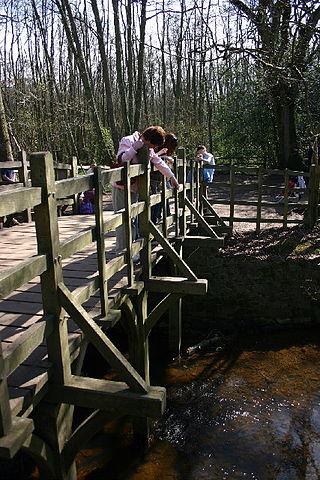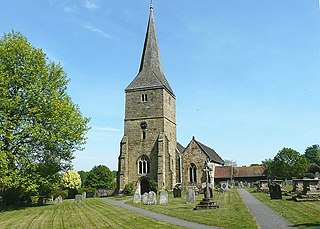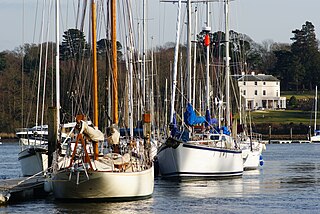
Alan Alexander Milne was an English writer best known for his books about the teddy bear Winnie-the-Pooh, as well as for children's poetry. Milne was primarily a playwright before the huge success of Winnie-the-Pooh overshadowed all his previous work. Milne served in both world wars, as a lieutenant in the Royal Warwickshire Regiment in the First World War and as a captain in the Home Guard in the Second World War.

Ashdown Forest is an ancient area of open heathland occupying the highest sandy ridge-top of the High Weald Area of Outstanding Natural Beauty. It is situated some 30 miles (48 km) south of London in the county of East Sussex, England. Rising to an elevation of 732 feet (223 m) above sea level, its heights provide expansive vistas across the heavily wooded hills of the Weald to the chalk escarpments of the North Downs and South Downs on the horizon.

Wealden is a local government district in East Sussex, England. Its council is based in Hailsham, the district's largest town. The district also includes the towns of Crowborough, Polegate and Uckfield, along with numerous villages and surrounding rural areas. The district's name comes from the Weald, the landscape and ancient woodland which occupies much of the centre and north of the area.

Poohsticks is a game first mentioned in The House at Pooh Corner, a Winnie-the-Pooh book by A.A. Milne. It is a simple game which may be played on any bridge over running water; each player drops a stick on the upstream side of a bridge and the one whose stick first appears on the downstream side is the winner. The annual World Poohsticks Championships have been held at Day's Lock on the River Thames in the UK since 1984.

Hartfield is a village and civil parish in the Wealden district of East Sussex, England. The parish also includes the settlements of Colemans Hatch, Hammerwood and Holtye, all lying on the northern edge of Ashdown Forest.

Christopher Robin Milne was an English author and bookseller and the only child of author A. A. Milne. As a child, he was the basis of the character Christopher Robin in his father's Winnie-the-Pooh stories and in two books of poems.

Charlwood is a village and civil parish in the Mole Valley district of Surrey, England. It is immediately northwest of London Gatwick Airport in West Sussex, close west of Horley and north of Crawley. The historic county boundary between Surrey and Sussex ran to the south of Gatwick Airport. Boundaries were reformed in 1974 so that the county boundary between Surrey and West Sussex, delineated by the Sussex Border Path, now runs along the northern perimeter of the airport, and the southern extent of Charlwood.

The Hundred Acre Wood is a part of the fictional land inhabited by Winnie-the-Pooh and his friends in the Winnie-the-Pooh series of children's stories by author A. A. Milne. The wood is visited regularly by the young boy Christopher Robin, who accompanies Pooh and company on their many adventures.

Hartfield was a railway station serving Hartfield, England, on the Three Bridges to Tunbridge Wells Central Line which closed in 1967, a casualty of the Beeching Axe.

Crewe Hall is a Jacobean mansion located near Crewe Green, east of Crewe, in Cheshire, England. Described by Nikolaus Pevsner as one of the two finest Jacobean houses in Cheshire, it is listed at grade I. Built in 1615–36 for Sir Randolph Crewe, it was one of the county's largest houses in the 17th century, and was said to have "brought London into Cheshire".

Winnie-the-Pooh is a fictional anthropomorphic teddy bear created by English author A. A. Milne and English illustrator E. H. Shepard. Winnie-the-Pooh first appeared by name in a children's story commissioned by London's Evening News for Christmas Eve 1925. The character is inspired by a stuffed toy that Milne had bought for his son Christopher Robin in Harrods department store, and a bear they had viewed at London Zoo.

Cornwall Terrace is a Grade I listed building of consecutive terraced mansions overlooking Regent's Park in the City of Westminster, London. It is situated at the park's southwest corner, near Baker Street, between York Terrace and Clarence Terrace, within the park's Crown Estate development. Cornwall Terrace was part of the scheme of the Prince Regent, later King George IV, to develop grand housing in Regent's Park. The buildings are Grade I listed buildings.

Moulsecoomb Place is a large 18th-century house on Lewes Road in the Moulsecoomb area of the English coastal city of Brighton and Hove. Originally a farmhouse based in an agricultural area in the parish of Patcham, north of Brighton, it was bought and extensively remodelled in 1790 for a long-established local family. It was their seat for over 100 years, but the Neoclassical-style mansion and its grounds were bought by the local council in the interwar period when Moulsecoomb was transformed into a major council estate. Subsequent uses have varied, and Moulsecoomb Place later became part of the University of Brighton's range of buildings. Student housing has been built to the rear; but much of the grounds, the house itself and a much older cottage and barn attached to the rear have been preserved. The house is a Grade II Listed building.

Buckhurst Park is an English country house and landscaped park in Withyham, East Sussex. It is the seat of William Sackville, 11th Earl De La Warr.

Tower House is a former private house in the Withdean area of the English coastal city of Brighton and Hove. Built in 1902 for a former jeweller to King Edward VII, it remained in private ownership until it was converted into flats and a daycare centre in 1988. It is one of the few large houses and villas to survive in the high-class Withdean area—many were demolished in favour of blocks of flats after World War II—and it has been described as "Brighton's finest example of a grand Edwardian house". English Heritage has listed the building at Grade II for its architectural and historical importance.

Cannon Hall at 14 Cannon Place, Hampstead, London is a grade II* listed building that dates from around 1720. The house is the former home of the actor Gerald du Maurier, his wife Muriel Beaumont, and their three children, the writers Angela du Maurier and Daphne du Maurier and the painter Jeanne du Maurier.

Folly Farm is an Arts and Crafts style country house in Sulhamstead, West Berkshire, England. Built around a small farmhouse dating to c. 1650, the house was substantially extended in William and Mary style by architect Edwin Lutyens c. 1906, and further extended by him in vernacular style c. 1912. It is a Grade I listed building. The gardens, designed by Lutyens and Gertrude Jekyll, are Grade II* listed in the National Register of Historic Parks and Gardens. They are among the best-known gardens of the Lutyens/Jekyll partnership.
Bentley Wood, also known as the House at Halland, is a Modernist house designed by the Russian émigré architect Serge Chermayeff and built in a rural location in the Low Weald in Sussex with views to the South Downs. In the Architects' Journal, Charles Herbert Reilly described it on completion in 1938 as "a regular Rolls-Royce of a house". It is considered to be one of the most influential modern houses of the period. It become a Grade II listed building in March 2020.

Brooklands is an 18th-century country house in Sarisbury in Fareham in the English county of Hampshire. The grounds of the house overlook the River Hamble. It has been listed Grade II* on the National Heritage List for England since October 1976.

Wellington Square is a garden square in Chelsea, London, off the south side of the King's Road. It was built in the first decades of the nineteenth century on the former site of a nursery owned by the florist and "well-known tulip-fancier" Thomas Davey and named after the Duke of Wellington. The square consists of 35 five-storey terraced stucco houses around a central garden with a fountain. The whole square is grade II listed with Historic England.


















